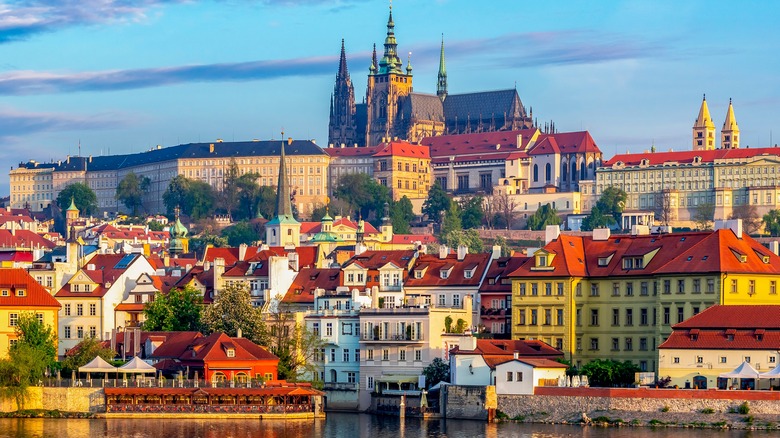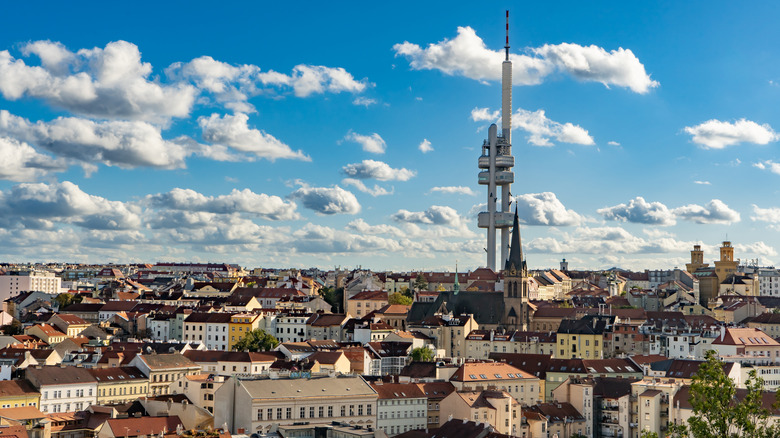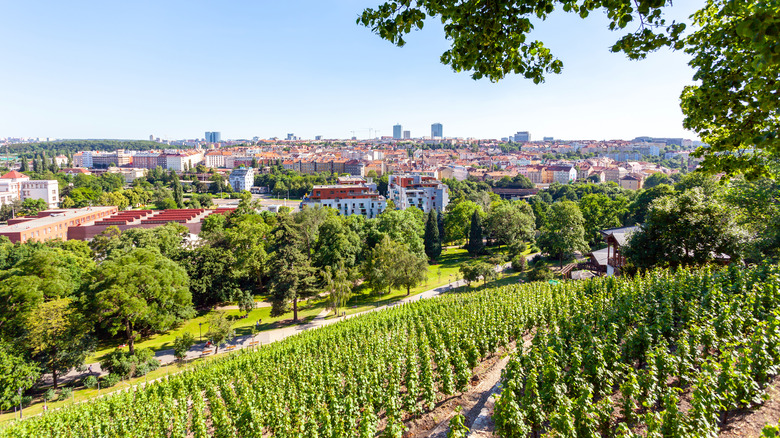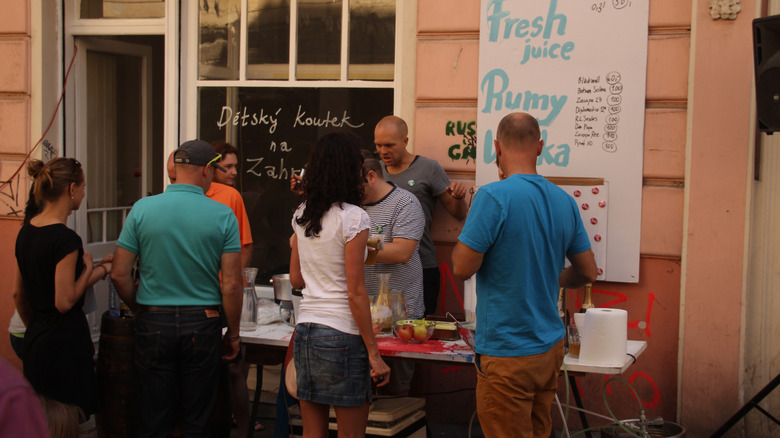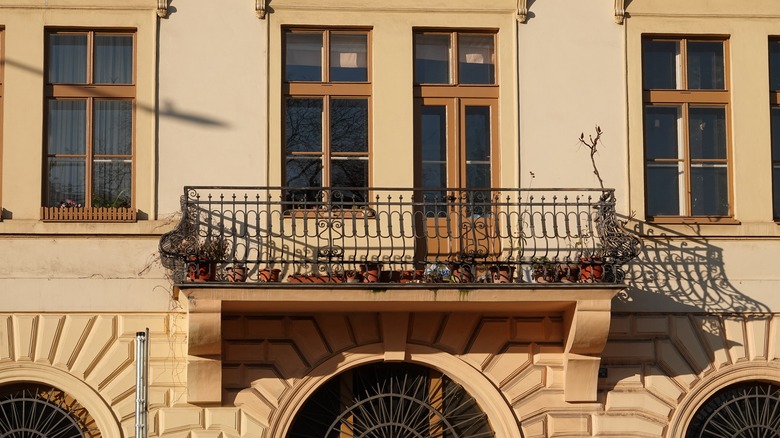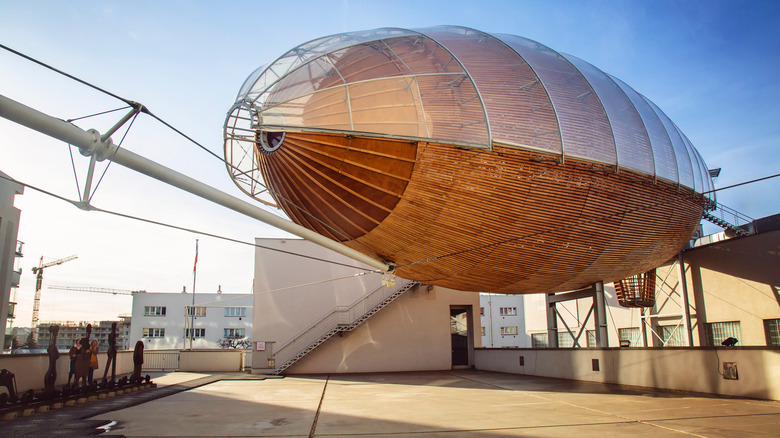Discover The Real Prague In These Five Neighborhoods Without Tourist Crowds
We may receive a commission on purchases made from links.
No one goes to Prague and comes back unimpressed. Most of the time, visitors speak of the Czech Republic's capital with stars in their eyes and gushes in their words — over the fairytale castles, cathedrals, and cobblestones that position Prague among the most beautiful cities in the world, if not the number 1. The evidence is particularly strong along the most beaten tourist path, running from Wenceslas Square to Prague Castle and reaching a peak on the iconic Charles Bridge, whose 30 statues and castle views seep with romance. It's easy to see why millions of tourists visit each year and why Prague always ranks high on the lists of once-in-a-lifetime vacation destinations you don't want to miss out on.
Unfortunately, relatively few visitors to Prague break from the pack to explore the neighborhoods where locals live, work, and play. These districts north and east of the city center reveal the face of 21st-century Prague, not so much in the age of the buildings but in the young and spirited faces of the inhabitants and entrepreneurs who've helped transform once-derelict neighborhoods into dynamic centers of art, culture, and business. Here is where Prague truly pushes boundaries and sharpens its cutting edge. Five neighborhoods stand out most: Žižkov, Vinohrady, Vršovice, Karlín, and Holešovice. Each offers an experience of Prague that may not look as pretty as Old Town but is arguably cooler.
Žižkov
Perhaps the first neighborhood of Prague to catch fire after the Velvet Revolution, Žižkov became a haven for the first waves of expats and hipsters, thanks to the cheap rent, tram connections, and history of housing artists, including Jaroslav Hašek, author of the seminal Czech novel, "The Good Soldier Švejk." The most famous Czech writer of all time, Franz Kafka, is buried in the district's Jewish cemetery. In recent decades, Žižkov has cleaned up its act a lot, applying a bougie veneer to its boutiques, cafés, wine bars, and restaurants. Still, there's plenty of the rough-and-ready available the deeper into the district you go.
Start any visit at Jiřího z Poděbrad Square. Under the gaze of the massive glass clock of the Church of the Most Sacred Heart of Our Lord, Praguers meet friends, walk their dogs, play music, and shop at the weekly farmer's market. Technically, the square is in the Vinohrady neighborhood, but it's the main entry point for Žižkov, which begins one block north. Keep going and reach the 700-foot Žižkov Television Tower that dominates the skyline. Crawling up its sides are 10 giant, creepy babies sculpted by Czech artist, David Černý. Other must-sees are the Olšany and New Jewish cemeteries containing Czech notables, lush greenery, and beautiful stonework. Also check out the hilltop monument to Jan Žižka, the district's namesake.
Vinohrady
Head south of Jiřího z Poděbrad Square and the pedigree rises. Indeed, the Vinohrady neighborhood was born with a silver spoon. Once covered in the royal vineyards that gave the district its name, the sloping hillsides grew elegant apartment blocks and parks in the late 19th century, and within a few decades, Vinohrady became the "it" neighborhood for intellectuals, artists, architects, and composers. The district was also home to a large Jewish population until the Holocaust. While somewhat sleepier than rabble-rousing Žižkov, Vinohrady still invites arm-in-arm strolls with its handsome buildings, quaint parks, and local vibe, as well as a number of memorable experiences.
Put Riegrovy Gardens at the top of any Vinohrady to-do list. This hilly park atop a former vineyard looks west across the city, making it the city's best spread of grass for a sunset. The park is also home to an expansive outdoor beer and restaurant garden that fills on weekends and for big games. Taste Vinohrady's wine past at Havlíček Gardens on the quieter south slope of the district. This Italian Renaissance-inspired garden still produces grapes and features a grotto water fountain. Peace Square, better known as Náměstí Míru, is Vinohrady's commercial center and home to the neo-Gothic Cathedral of St. Ludmila and art nouveau Vinohrady Theatre. The square is also a great stop during the European Christmas market season, thanks to its fantastic Christmas market.
Vršovice
Every metropolis has its up-and-coming district where the young, hip, and entrepreneurial make their scene. In Prague today, that's Vršovice. South and east of Vinohrady, the district covers a downward slope as it descends into a pocket of crisscrossing streets filled with slapdash bars, boutiques, clubs, and cafés. This is particularly prominent along Krymská Street, which serves as both the main street and outdoor promenade. On weekends and during special events, Krymská becomes a sight in itself, hosting one continuous party along its length and spilling into connecting streets that's infectious to folks of all ages. This area is also home to two cafés that ooze ambiance, the 1930s-style Café Sladkovský and the Botanica Coffee Truck inside a plant shop and botanical garden.
Outside the Krymská Street area, Vršovice turns largely workaday, with a few worthwhile sights and experiences. These include the functionalist, block-style Saint Wenceslas Church built in 1929 and Kino Pilotů, a cinema founded in the 1930s by the Association of Czechoslovak Aviators that screens arthouse films, often with English subtitles. Vršovice also sees a lot of soccer fans, as it's home to two teams: SK Slavia Prague and Bohemians 1905. The first plays in Fortuna Arena and Ďolíček Stadium, both in the district.
Karlín
Along a bend in the Vltava River, north of Žižkov, lies another transformed district that's almost unrecognizable to those who remember its rough-and-tumble days before the 2002 floods that damaged and destroyed much of it. Ironically, the event launched a revitalization plan that's made Karlín a coveted address today. Food and drink play a leading role in this, helping to make it a destination for culinary adventurers seeking the cutting edge of the Czech food scene — or at least a break from goulash. That's also why it hosts the annual Karlín Street Food Festival, with 50 stalls of gastronomy alongside live music.
In the meantime, a number of great bistros, cafés, and restaurants can waltz on your taste buds. The highest status — Bib Gourmand by Michelin — goes to Eska, a sleek, sunlight-bathed café and bakery inside a former fabric factory. Other great eateries in Karlín include Bistro Proti Proudu, Pohostinec Karlín, and Polévkárna. Those chasing with a shot of caffeine head to Muj Sálek Kávy for coffee or Tea Mountain for tea. For beer, pull up a chair at the microbreweries Dva Kohouti and Vrátnice, or stroll over to Beer Garden Karlín on the riverbank. Along the way, stop by The Church of St. Cyril and Methodius, a 19th-century neo-Romanesque gem.
Holešovice
If any Prague neighborhood can lay claim to the cool crown, it may be Holešovice. Wrapped inside a sharp bend in the Vltava River across from the Karlín side, it's become the city's de facto arts capital. This starts at the Dox Center for Contemporary Art, marked by the 130-foot steel and wood Zeppelin on top. Here, attend exhibitions, events, workshops, and more. More art experiences are in Holešovice Market, Prague's main cattle market and slaughterhouse until the 1970s. Current residents include Jatka78 theater and art space, and Trafo Gallery. Nearby is La Fabrika cultural center, which also hosts theater, dance performances, and concerts. Find Picassos, Renoirs, van Goghs at National Gallery Prague in The Trade Fair Palace.
Holešovice's artsy sensibilities also translate into its restaurants and cafés, particularly Vnitroblock, a multi-functional space beloved for its industrial-chic café and boutique of local designers. Elsewhere in Holešovice, the petite, Bistro 8 serves an excellent brunch, while The Eatery channels the skills of a Michelin-starred chef into modern European dishes. SaSaZu serves probably the best Asian fusion in Prague, before sending diners into its 2,500-person concert hall next door. The district is also home to one of the city's most exquisite secret gardens, in the backyard of Cukrárna Alchymista cake shop, where tables mingle with flower gardens and fish ponds. All this and more makes it easy to understand why Prague ranks so high among Rick Steves' favorite places in Europe.
